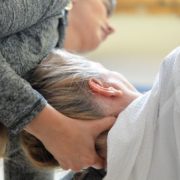Neck Pain During Crunches? 3 Reasons why and what you can do.
Abdominal crunches are one of the most popular “ab exercises” around. It’s a move that emphasizes your upper abdominal strength more so than your lower. You start by lying on your back – typically hands behind your head and knees bent – then lift your head and chest off the floor – “crunching” your upper body into a C-shaped curve.
Over the years, many healthcare and fitness professionals have dismissed this exercise entirely claiming its ineffectiveness for working the core. While I agree that it shouldn’t be the only core exercise you do – the abdominal crunch does have its place. When done correctly, mastering this move can help you get up from the floor, and sit up out of bed with more ease and less risk of injury. And of course, you see this move a lot in exercise classes, so it’s important to know how to do this move correctly without hurting your neck.
If you’re feeling crunches in your neck instead of your abs – here are the biggest problems I see and why they might be hurting you.
1. You’re not using your abs.
This sounds pretty obvious, right? Of course you use your abs when you crunch. Anatomically-speaking – it would be impossible for you to perform this move without some form of engagement with your abs. But many people don’t engage their abs enough or in the right way. And this can result in neck pain.
Here’s what happens.
If you don’t engage your abs enough or in the right way during a crunch – your neck will often kick in to try and help. Eventually your neck gets sore from this because your neck muscles aren’t designed to be the primary mover during a crunch. One easy tip to try next time you do a crunch is to make sure you inhale deeply – and then exhale as you begin to crunch. At the same time, check in with your neck. Make sure you can easily turn and wiggle it side to side. If that is challenging – then you are likely using your neck to help you crunch and your abdominal engagement could use some work.
2. Your neck is in the wrong position.
When you’re doing an abdominal crunch your neck position is critical. There is an illusion that your neck moves during the crunch but it should actually stay pretty stationary. The ideal position for your neck is to begin with a slight nod of the chin (like you’re nodding “yes”) and then keep it there. The rest of the curling motion will come from contracting your abdominals to move your trunk. As you curl up, you want to keep a nice C-shaped curve of your upper body – and keep a tennis ball’s distance between your chin and chest.
Most people either curl their neck too much, or not enough. If your chin is touching your chest you’re curled too much – and you’ll experience strain behind your neck. And if you keep your neck too straight you’ll experience strain in the front of your neck. Another common mistake with neck positioning during a crunch is jutting your head forward. This will put strain in your upper neck right behind your head. While any of these positions will cause temporary discomfort in your neck – they could lead to more long-standing problems down the line if not corrected.
3. You have an underlying neck problem.
Sometimes you will get all of the above right – and still have neck pain when you perform an abdominal crunch. This could be a sign that you have an underlying neck problem – and doing a lot of crunches has just exposed it.
Let me explain.
Let’s say you have a small bulging disc in your neck that you weren’t aware of, or you thought was “fixed”. The curled position of your neck during a crunch can exacerbate this problem, even if you are using your abs correctly and following every tip I just mentioned above.
Pay attention to what you feel during and after performing an abdominal crunch. If you notice pain that shoots into your shoulder blade, or any numbness or tingling down your arm (especially if past your elbow) – these are clues you could have an underlying neck problem that is being aggravated by crunching. You might experience these symptoms during your crunches, or even up to several hours after. Either way, symptoms like this could be a sign there is more to your neck pain than simply incorrect crunch-technique or weakness in your abs. And it would be important to talk to an expert about this.
If you’re experiencing neck pain during abdominal crunches – hopefully these tips give you a better understanding why – but most importantly – please know this is a very common issue and you’re not alone.
It’s partly why I created Pilates 101: Get [Your] Back to Health™
Although this program is primarily geared toward helping folks who’s back pain is keeping them from strengthening their core and exercising the way they want to…
We actually talk quite about about the relationship between your abdominals and your neck – and teach you how to “crunch” safely and correctly.
I’ve been personally teaching this program for the past 4 years – and previously – you could only do it live with me 1-2x per year…
But NOW – I’m excited to tell you that we’ve opened it up to the entire world!
We’ve had people signing up from all across the country right now – people who’ve been wanting to get help from me but couldn’t because of where they were located.
This program is not for everyone – but if you want to learn more and see if it might be for you – CLICK HERE.
Dr. Carrie Jose, Physical Therapist and Pilates expert, owns CJ Physical Therapy & Pilatesin Portsmouth, NH. To get a free copy of her guide to taking care of back pain – click here.



